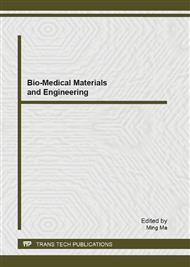p.359
p.362
p.366
p.371
p.377
p.384
p.388
p.394
p.401
Identification of DMSA-Coated Fe3O4 Nanoparticles Induced-Apoptosis Response Genes in Human Monocytes by cDNA Microarrays
Abstract:
This study investigated the cell apoptosis and gene expression profiles of human THP-1 monocytes in order to identify the molecular mechanism of cell apoptosis induced by meso-2,-3-dimercaptosuccinnic acid-coated Fe3O4 magnetic nanoparticles. Cell apoptosis was visualized with flow cytometry after treated by 50 and 100 μg/ml Fe3O4 nanoparticles, and the gene expression profiles were detected with Affymetrix Human Genome U133 Plus 2.0 GeneChips® microarrays. The transmission electron microscopy obserbation revealed that THP-1 cells were effectively labeled by the Fe3O4 nanoparticles. The internalized Fe3O4 nanoparticles increased cell apoptosis in a dose-dependent manner, but not decreased cell viability significantly. The cDNA microarray results showed that hundreds of genes were significantly regulated at the concentration of 50 and 100 μg/ml, and the level of these genes exhibited a dose response, including CD14, CD86, CFLAR, IL-1, NFKBIA, NLRC4, NAIP and AIP3. The Fe3O4 nanoparticles treatments resulted in significantly altered in Toll-like receptor signaling pathway, NOD-like receptor signaling pathway, and Cell apoptosis signaling pathway. Gene ontology analysis of these differentially expressed genes demonstrated that mainly up-regulated genes were related to cytokine production and cell apoptosis. These results showed that the Fe3O4 nanoparticles induced THP-1 cells apoptosis and the level of lots of genes involved in extrinsic apoptosis pathway differentially expressed, which further revealed demonstrated the relation between Fe3O4 MNPs treatment and cell apoptosis.
Info:
Periodical:
Pages:
377-383
Citation:
Online since:
August 2013
Authors:
Price:
Сopyright:
© 2013 Trans Tech Publications Ltd. All Rights Reserved
Share:
Citation:


